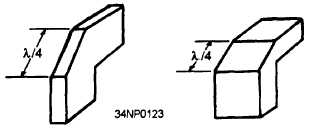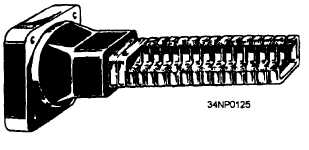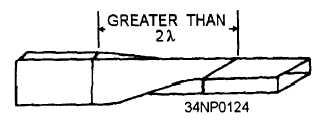A sharp bend in either dimension may be used
if it meets certain requirements. Notice the two
45-degree bends in figure 3-50; the bends are 1/4l
apart. The reflections that occur at the 45-degree bends
cancel each other, leaving the fields as though no
reflections have occurred.
Figure 3-50.—Sharp bends.
Sometimes the electromagnetic fields must be
rotated so that they are in the proper phase to match
the phase of the load. This may be accomplished by
twisting the waveguide as shown in figure 3-51. The
twist must be gradual and greater than
Figure 3-51.—Waveguide twist.
The flexible waveguide (fig. 3-52) allows special
bends, which some equipment applications might
require. It consists of a specially wound ribbon of
conductive material, the most commonly used is brass,
with the inner surface plated with chromium. Power
losses are greater in the flexible waveguide because
the inner surfaces are not perfectly smooth. Therefore,
it is only used in short sections where no other
reasonable solution is available.
Waveguide Joints
be
Since an entire waveguide system cannot possibly
molded into one piece, the waveguide must be
Figure 3-52.—Flexible waveguide.
constructed in sections and the sections connected with
joints. The three basic types of waveguide joints are
the PERMANENT, the SEMIPERMANENT, and the
ROTATING JOINTS. Since the permanent joint is
a factory-welded joint that requires no maintenance,
only the semipermanent and rotating joints will be
discussed.
Sections of waveguide must be taken apart for
maintenance and repair. A semipermanent joint, called
a CHOKE JOINT, is most commonly used for this
purpose. The choke joint provides good electromag-
netic continuity between the sections of the waveguide
with very little power loss.
A cross-sectional view of a choke joint is shown
in figure 3-53. The pressure gasket shown between
the two metal surfaces forms an airtight seal. Notice
in view B that the slot is exactly
from the “a”
wall of the waveguide. The slot is also
deep,
as shown in view A, and because it is shorted at point
1, a high impedance results at point 2. Point 3 is
from point 2. The high impedance at point 2 results
in a low impedance, or short, at point 3. This effect
creates a good electrical connection between the two
sections that permits energy to pass with very little
reflection or loss.
Whenever a stationary rectangular waveguide is
to be connected to a rotating antenna, a rotating joint
must be used. A circular waveguide is normally used
in a rotating joint. Rotating a rectangular waveguide
would cause field pattern distortion. The rotating
section of the joint, illustrated in figure 3-54, uses a
choke joint to complete the electrical connection with
the stationary section.
The circular waveguide is
designed so that it will operate in the TM0,1 mode.
3-23






